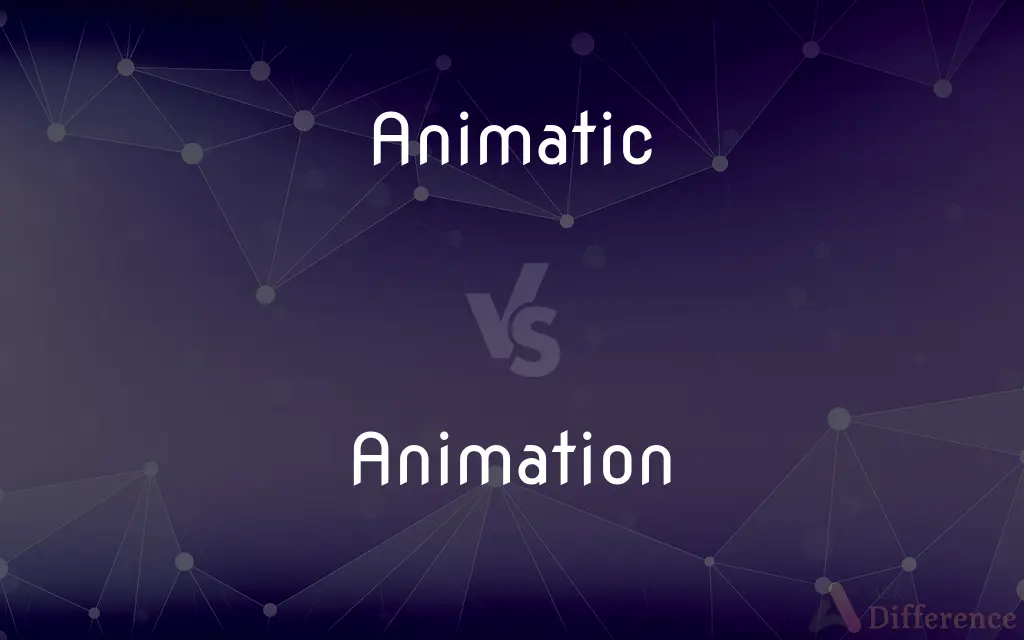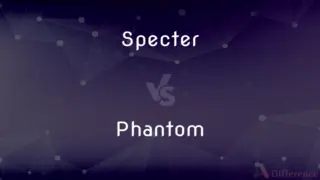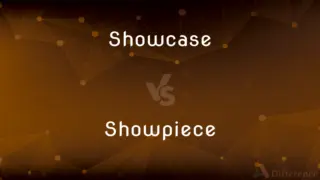Animatic vs. Animation — What's the Difference?
Edited by Tayyaba Rehman — By Fiza Rafique — Updated on April 2, 2024
Animatics serve as a preliminary version of an animation, showcasing the sequence of scenes through still images and basic movements. Animation, however, is the finalized, fully realized version with detailed graphics and smooth motion.

Difference Between Animatic and Animation
Table of Contents
ADVERTISEMENT
Key Differences
Animatics are essentially animated storyboards, used to visualize and plan the flow of a story or sequence in film and animation projects. They typically feature simple sketches and minimal movement. Animation, on the other hand, is the process of creating the illusion of motion and shape change by rapidly displaying a sequence of static images that minimally differ from each other.
While animatics are crucial for pre-visualization, allowing creators to experiment with different pacing, timing, and scene compositions without incurring high costs, animation involves detailed work, including character design, backgrounds, and fluid motion, representing the final product intended for the audience.
Animatics often use temporary soundtracks, voiceovers, and sound effects to simulate how the final piece will look and feel, aiding in editing and pacing decisions. Animation, whereas, integrates the final versions of all auditory and visual elements, resulting in a polished and complete viewing experience.
The transition from animatics to animation allows for adjustments and refinements based on feedback and creative direction. While animatics set the foundational blueprint, animation brings the project to life, focusing on aesthetic appeal, storytelling, and audience engagement.
Comparison Chart
Purpose
Pre-visualization and planning
Final presentation
ADVERTISEMENT
Complexity
Basic sketches, minimal movement
Detailed graphics, smooth motion
Sound
Temporary soundtrack and effects
Final soundtrack, voiceovers, and effects
Use in Production
Early stage to experiment and refine ideas
Final stage to produce the completed work
Viewer Experience
Basic understanding of story flow
Fully realized story with immersive experience
Compare with Definitions
Animatic
Simple and cost-effective.
Creating an animatic involves less time and resources, making it a practical first step.
Animation
Finalized visual storytelling.
Animation brings stories to life with detailed visuals and smooth motion.
Animatic
Storyboard sequence.
Animatics visualize the sequence of scenes, providing a rough idea of the story's flow.
Animation
Complete audiovisual experience.
Final sound effects and music in animations enhance the storytelling.
Animatic
Pre-visualization tool.
Animatics are used to storyboard films, allowing for early visual planning.
Animation
End product of creative process.
Animation represents the culmination of the creative and production processes.
Animatic
Basic sound elements.
Temporary voiceovers in animatics help in pacing the narrative before final production.
Animation
Detailed artwork and motion.
Animations involve intricate character designs and background art.
Animatic
Feedback and adjustments.
Animatics allow filmmakers to make adjustments early in the production process.
Animation
Engages the audience.
The detailed animation captures and retains the viewer's attention through visual storytelling.
Animatic
A preliminary animated version of a scripted movie or television program.
Animation
Animation is a method in which figures are manipulated to appear as moving images. In traditional animation, images are drawn or painted by hand on transparent celluloid sheets to be photographed and exhibited on film.
Animatic
An animated storyboard used as a rough preview of a film or advertisement.
Animation
The act, process, or result of imparting life, interest, spirit, motion, or activity.
Animation
The quality or condition of being alive, active, spirited, or vigorous.
Animation
The art or process of making movies with drawings, computer graphics, or photographs of static objects, including all techniques other than the continuous filming of live-action images.
Animation
Images or special effects created through animation.
Animation
The act of animating, or giving life or spirit.
Animation
The technique of making inanimate objects or drawings appear to move in motion pictures or computer graphics; the object (film, computer game, etc.) so produced
Animation
The state of being lively, brisk, or full of spirit and vigor; vivacity; spiritedness
He recited the story with great animation.
Animation
The condition of being animate or alive.
Animation
(linguistics) conversion from the inanimate to animate grammatical category
Animation
Activities offered by a holiday resort encompassing activities that include movement, joy, leisure and spectacle, such as games, sports, shows, events, etc.
Animation
The act of animating, or giving life or spirit; the state of being animate or alive.
The animation of the same soul quickening the whole frame.
Perhaps an inanimate thing supplies me, while I am speaking, with whatever I possess of animation.
Animation
The state of being lively, brisk, or full of spirit and vigor; vivacity; spiritedness; as, he recited the story with great animation.
Animation
The condition of living or the state of being alive;
While there's life there's hope
Life depends on many chemical and physical processes
Animation
The property of being able to survive and grow;
The vitality of a seed
Animation
Quality of being active or spirited or alive and vigorous
Animation
The activity of giving vitality and vigour to something
Animation
The making of animated cartoons
Animation
General activity and motion
Common Curiosities
What distinguishes animation from animatic?
Animation is the finalized version with detailed graphics and full motion, unlike the preliminary and simpler animatic.
Can animatics have sound?
Yes, animatics often include temporary soundtracks, voiceovers, and sound effects to simulate the final piece.
What is the main purpose of animation?
The main purpose of animation is to tell a story or convey a message through the illusion of motion, providing a fully realized audiovisual experience.
What types of projects use animatics?
Film, television, video games, and other visual media projects use animatics during their early planning stages.
How detailed are animatics?
Animatics are less detailed, featuring basic sketches and minimal movements to outline the story’s flow.
What is an animatic?
An animatic is a pre-visualization tool that uses basic sketches and minimal movements to outline a story or sequence.
Do animatics require the same skill set as animation?
While related, animatics generally require more emphasis on storyboarding and planning, whereas animation focuses on detailed artistry and motion.
How do animatics assist in the creative process?
Animatics allow creators to experiment with different storytelling elements and make adjustments early in the production process.
Why are animatics used in animation production?
Animatics help in planning the narrative flow, scene compositions, and pacing before committing to the detailed work of animation.
What role does feedback play in moving from animatic to animation?
Feedback on the animatic can lead to adjustments in the narrative, pacing, and scene composition, influencing the final animation.
Can the public view animatics?
Animatics are sometimes released as part of a project’s behind-the-scenes content, but they are primarily used internally during the production process.
What makes animation engaging to audiences?
Detailed graphics, smooth motion, and complete audiovisual elements make animation engaging and immersive for audiences.
How long does it take to transition from animatic to animation?
The time can vary widely depending on the project’s complexity and scope, ranging from weeks to several months.
Are animatics and animations used together?
Yes, animatics are used in the planning phase, and based on this blueprint, the final animations are created.
How has technology impacted animatics and animation?
Technology has made both animatics and animation more efficient and accessible, enhancing quality and allowing for more creative experimentation.
Share Your Discovery

Previous Comparison
Specter vs. Phantom
Next Comparison
Showcase vs. ShowpieceAuthor Spotlight
Written by
Fiza RafiqueFiza Rafique is a skilled content writer at AskDifference.com, where she meticulously refines and enhances written pieces. Drawing from her vast editorial expertise, Fiza ensures clarity, accuracy, and precision in every article. Passionate about language, she continually seeks to elevate the quality of content for readers worldwide.
Edited by
Tayyaba RehmanTayyaba Rehman is a distinguished writer, currently serving as a primary contributor to askdifference.com. As a researcher in semantics and etymology, Tayyaba's passion for the complexity of languages and their distinctions has found a perfect home on the platform. Tayyaba delves into the intricacies of language, distinguishing between commonly confused words and phrases, thereby providing clarity for readers worldwide.















































